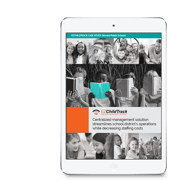
Deciding to purchase and implement a childcare management system should be approached as a multi-step process. It requires planning and consideration before you approach vendors about their solutions as well as planning for the transition to the new system and continuing support.
The following tips are a tried and true method of selecting, installing, training, and implementation of a new childcare management software system.
Tip #1: Needs Assessment
Before looking at the solutions available, you and your staff need to document your current system.
- How does each process occur?
- Who is involved in each process?
- How do the processes and people fit together?
- Are there places for improvement before implementing software?
Look at your current resources to determine if you will require additional hardware or personnel. How computer-literate is your staff? How do you communicate data now?
If you have not done so before, now is a good time to write down each process, step-by-step. You will be able to identify possible improvements to your childcare, duplication of work, and use the documentation to set up your new system.
Tip #2: Budgeting
Above all, be realistic with your budget. The most expensive solution is not necessarily the best. The least expensive solution may not turn out to be such a bargain. Also, there are costs other than the software to consider, such as:
- Computers and an internet connection
- IT staff or consultant time
- Cost of lost productivity as the system is implemented
- The time required to do double data entry as you begin the transition
- Annual software maintenance costs
Some costs may not be included depending on whether you choose on-premise software or a cloud-based solution.
Tip #3: Define Requirements
If you have a large childcare business or one with multiple locations, form a committee to manage the next steps. Even with a smaller business, you will want to include staff members as you define requirements and look into alternatives.
With a committee, you will have specific people managing the project, leaving others to continue daily operations and pick up where committee members must be absent. You need representation from the executive level on down.
- Executive sponsor: This is the person in upper management who will provide authority and maintain communication with the rest of the executive staff.
- Line staff: These are the people who perform the daily work and are most familiar with the processes.
- Include a range of roles and responsibilities
- Identify a champion or key driver to advocate for the project among staff and executives
Tip #4: Define Requirements
You want to do requirements definition before you begin looking at solutions. You have been running this business in a certain way, and you have the best knowledge of what works and what doesn’t.
Looking at solutions before you know what you need it to do will simply cause confusion, and the system you select may not perform as expected.
As you go through your requirements, consider if this is a good time to do more than the essentials. Create a document with clearly defined needs, what the system must be able to do. A second list can be created containing a list of “nice-to-haves” or “perfect world” items.
Use these documents to develop a request for proposal to send out to potential vendors or to use as the committee evaluates vendors.
Tip #5: Vendor Selection
Create a short list of vendors, no more than four or five that seem able to meet your requirements. The committee should evaluate each vendor according to the document and ask the same questions of every vendor. You want to compare apples to apples as much as possible.
Once the committee selects a vendor, begin building a business case or justification for selecting this vendor and purchasing a solution.
- What is the expected return on investment (ROI)?
- What is the total cost of ownership for the solution?
- What value does the system provide in comparison to the cost?
A good vendor can and should help you with these items because it has worked with others in your industry with similar businesses. The vendor and your own research can tell you how long it will take the system to pay for itself because it saves costs or produces higher revenues.
The total cost of ownership not only tells you how you should structure your budget over time but it can also help you compare the vendor's solution to a competitor's or an alternative method.
How much does it cost you to continue doing business as you have been in comparison to the cost of using a new software solution regarding saved time, increased productivity, or higher profits?
If the committee is unable to make a choice, re-evaluate your budget and your requirements. Is it possible to do the project in phases or modules? You may be able to stretch the costs out over several months instead of paying all at once.
Make sure the contract with the vendor includes an appropriate service level agreement that includes implementation, training, and technical support. You may be able to get the vendor to help with data transfer.
Tip #6: Implementation
Set realistic timelines for installing and configuring the solution, so it follows your processes. The vendor should guide you with implementation, but it is your project.
- Lock in schedules, especially for training
- Map your processes to the new software
- Create a roll-back plan in case you have problems
- Consider using an 80/20 rule - if the solution fits 80% of your processes, you can fit the other 20% into the software
If you are implementing an extensive new system, it may be helpful to take it in phases to keep productivity up. Start with the most necessary parts and work your way to the nice-to-haves as your system is configured.
Tip #7: Training
Take full advantage of all training offered by the vendor. Ask if there are online tutorials for new staff in the future and refresher training. Consider having one or more "super-users" to act as subject matter expert on the system for staff to approach as needed.
As you train, you can test the system with the staff that will use it on a daily basis. Listen for issues or ask for feedback to help smooth the transition.
Tip #8: Plan for Updates
A good software vendor provides regular updates with new features and fixes to problems. Find out what happens to your configuration when an update is pushed out. If you are using a cloud-based system, updates are part of the service, but find out when they are scheduled to be implemented so you can be prepared.
A new childcare management system is meant to improve your productivity and provide more time to be with the children in your after school program, school, or center. If you take care during the selection process and work with the vendor for configuration and training, your transition should go as smoothly and improve your operations.




